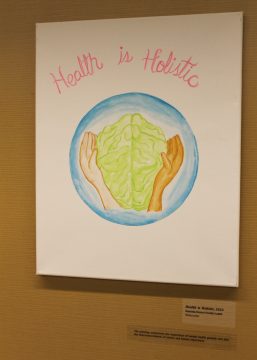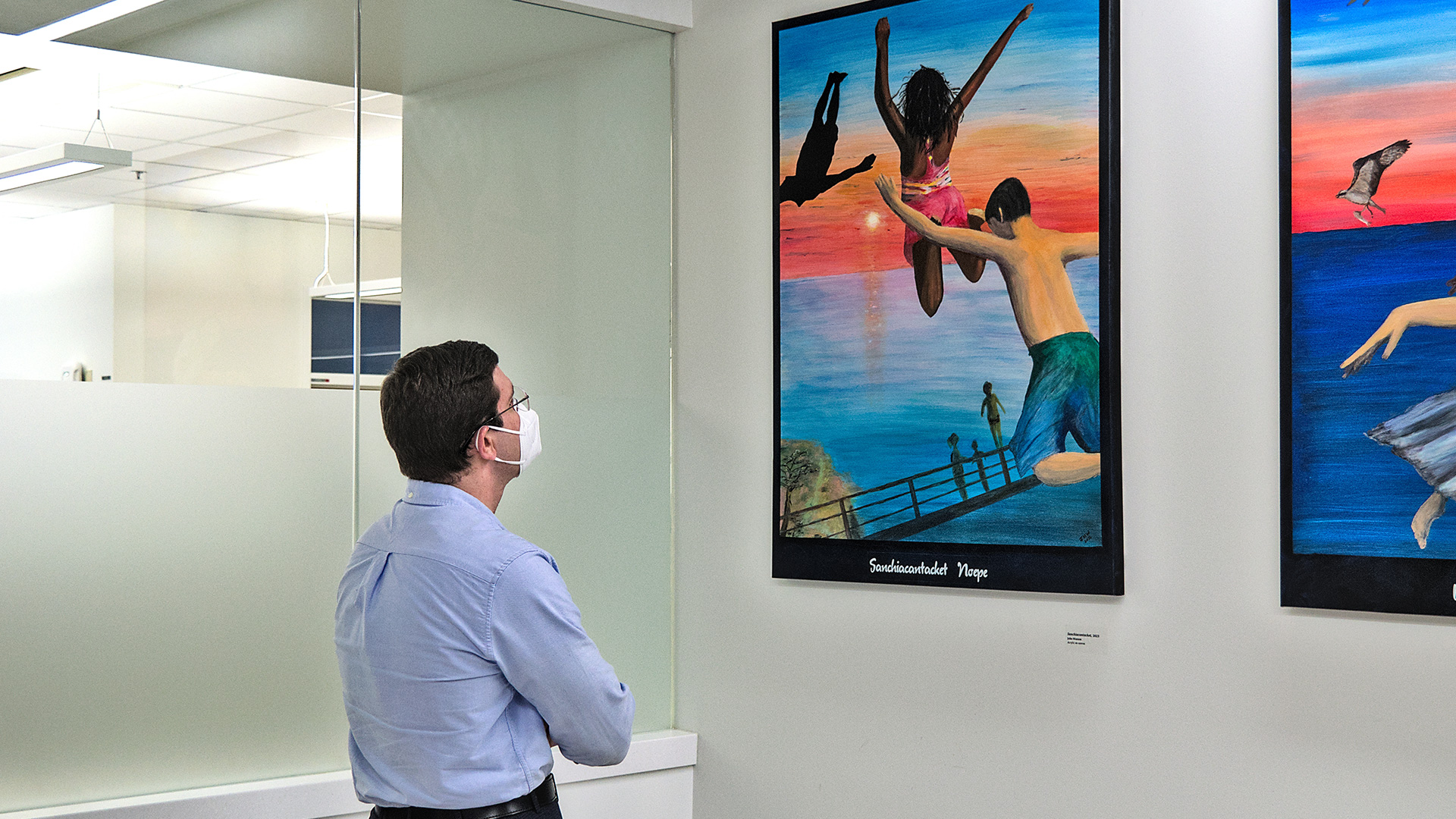Serving as an excellent example of the important role that the arts and humanities play in healing and health, Dartmouth Health hosted its fourth Annual Arts and Humanities in Medicine Symposium on January 27. Following the symposium, The Dartmouth Institute for Health Policy and Clinical Practice hosted an art exhibition and reception at DH, serving as a fitting end to the day’s interactive presentations.
The symposium featured talks from researchers and practitioners from Geisel School of Medicine, Dartmouth Health (DH), and Dartmouth College as well as the University of Rochester—sharing the impact that music, art, and the humanities are having on patient care through a number of innovative projects. (See highlights from three of the symposium talks, as well as TDI’s art exhibition, below. A video of the full symposium will be available soon here)
“We were very pleased with the turnout which included almost 100 people per session,” said Marianne Barthel, director of the Arts and Humanities Program at Dartmouth Hitchcock Medical Center (DHMC). “We strive to hit a broad number of subjects because our field is so broad—including research, patient care, and interaction with our community and our students. For the size of our institutions and our staffing in those areas, I think we do incredible work, and we are a leader in many ways.”
Healing Arts Engage Patients
 Bans on family visitation during the COVID-19 pandemic created significant challenges for postoperative engagement and orientation in older adults. To address this gap, trauma and acute care surgeon Alexandra Briggs, MD, an assistant professor of surgery at Geisel and co-director of the geriatric surgery program at DH, worked with colleagues to explore whether a proactive partnership with DH’s Creative Arts program would facilitate geriatric patient engagement.
Bans on family visitation during the COVID-19 pandemic created significant challenges for postoperative engagement and orientation in older adults. To address this gap, trauma and acute care surgeon Alexandra Briggs, MD, an assistant professor of surgery at Geisel and co-director of the geriatric surgery program at DH, worked with colleagues to explore whether a proactive partnership with DH’s Creative Arts program would facilitate geriatric patient engagement.
“We know that older adults are at higher risk for poor outcomes after surgery, with delirium—an acute state of confusion—being a particularly difficult and costly complication,” she explained. Among other interventions, engaging patients through virtual concerts, therapeutic harpist visits, art, and writing activities can help with orientation and prevent delirium.
To date, their targeted creative arts program has yielded more than 200 completed visits and has resulted in positive feedback from staff and patients. “It’s feasible and incredibly useful. We’ve demonstrated that here and we need to do more,” said Briggs.
Keynote: Music and Epilepsy
Research involving people with drug-resistant epilepsy has shown that listening to some music, particularly Mozart’s Sonata for Two Pianos in D Major (also known as KV 448) may decrease the probability of clinical seizures and their related comorbidities. Understanding the results required collaboration between experts in neurology and music theory.
When Barbara Jobst, MD, chair of the Department of Neurology and Neurocritical Care at DH and a professor of neurology at Geisel, first heard about the “KV448 effect,” she was skeptical. “I thought, ‘this can’t be true,’ but if you doubt something as a physician you better go and study it,” she said.
After conducting extensive research with Michael Casey, PhD, a professor of music and computer science at Dartmouth, and many others, Jobst and her colleagues found that the Mozart piece does in fact reduce epileptiform activity and may possibly have an effect on memory.
“Our big hope as physicians and musicians is to one day engineer some music that is anti-epileptic and can possibly do something for memory,” she said. “We have Mozart, but to listen to Mozart all day to the same sonata is quite tiresome. We have to come up with better ways to find more music that has the same effect.”
Positive Exposure Fights Stigma
In the symposium’s final presentation, Eleonore Baughan, a second-year medical student at Geisel, and Kathy Kirkland, MD, a professor of medicine and of health policy and clinical practice at Geisel and section chief and director of palliative medicine at DH, talked about their photography project working with Positive Exposure.
Positive Exposure is a nonprofit organization that uses photography to empower and humanize people with physical differences. “Last spring, we brought a Positive Exposure exhibition to DHMC featuring 30 portraits for about eight weeks,” said Baughan, noting that their mission was to help fight stigma and create a more inclusive community.
Kirkland explained that the exhibition was paired with a narrative medicine experience in which participants responded to writing prompts in a facilitated group or a self-guided option—with the prompts inviting them to imagine the specifics of what life might be like for the people featured in the portraits. She repeated this exercise with symposium participants after sharing some of the photos.
Reflecting on the value of the project, Kirkland said, “I think it was Anais Nin who said, ‘We don’t see things as they are, we see them as we are.’ To me, the real opportunity when looking at these portraits was being able to see somebody else’s perspectives.”
Human Connection through Art
Following the Arts & Humanities in Medicine Symposium, The Dartmouth Institute held an art exhibition and reception in its Williamson 5th-floor space at DHMC, featuring the work of 10 affiliated artists.
The event was the brainchild of Eleni Fanouraki, MPH ’22, who works as a research assistant for Amber Barnato, MD, MPH, MS, the John E. Wennberg Distinguished Professor in Health Policy and Clinical Practice and director of The Dartmouth Institute. Fanouraki designed the exhibit as an interactive model of presentation, inviting visitors to view a variety of artwork—from photography to paintings to paper mache.
“Community engagement is a big part of decision making in public health,” Fanouraki said. “This event was designed to facilitate unstructured connections among students, staff, and faculty to enhance our sense of community across disciplines.”
“I think this is a great idea,” said Craig Westling, DrPH, MPH, MS, executive director of education at The Dartmouth Institute, who was one of many faculty members and students who turned out for the event. “The last three years we’ve all been separated so much. Not only is this a way to gather but it’s a way to gather in a very personal way. I am grateful to the artists for sharing their work and expressing themselves in ways that you don’t typically see.”
Commenting about the inspiration for a water-color painting called “Health is Holistic,” Roland Lamb, MPH, residential MPH/MS program manager at The Dartmouth Institute, said, “It was a team endeavor with my wife Daniela. The painting emphasizes the importance of mental health globally and the interconnectedness of nature and human experience. It also has to do with caring for people from all diverse backgrounds.”
Kaitlyn Mi, a graduate student at The Dartmouth Institute, shared her motivation to produce digital artwork of a human hand pressed on canvas. “I thought it would be a fun way to express myself and to expand upon some skills that I learned taking biomechanics and medical illustration classes in college,” she explained. “I took a very literal, medical route to show different parts of the hand, but I think it’s really interesting to see how people can express their thoughts about medicine and public health in so many different ways.”
“I’m grateful to the artists that participated with their works and for understanding this need to ‘share’,” said Fanouraki. “Hopefully, we can make it an annual event.”
The exhibition will be open to the public until Feb 12th during business hours.
